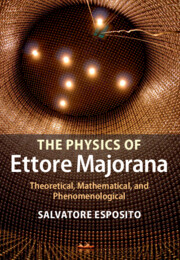Book contents
- Frontmatter
- Contents
- Acknowledgments
- Part I Introducing the character
- Part II Atomic physics
- Part III Nuclear and statistical physics
- Part IV Relativistic fields and group theory
- Part V Quantum field theory
- Part VI Fundamental theories and other topics
- 11 A “path integral” approach to quantum mechanics
- 12 Fundamental lengths and times
- 13 Majorana's multifaceted life
- Part VII Beyond Majorana
- Appendix Molecular bonding in quantum mechanics
- References
- Author index
- Subject index
12 - Fundamental lengths and times
Published online by Cambridge University Press: 18 December 2014
- Frontmatter
- Contents
- Acknowledgments
- Part I Introducing the character
- Part II Atomic physics
- Part III Nuclear and statistical physics
- Part IV Relativistic fields and group theory
- Part V Quantum field theory
- Part VI Fundamental theories and other topics
- 11 A “path integral” approach to quantum mechanics
- 12 Fundamental lengths and times
- 13 Majorana's multifaceted life
- Part VII Beyond Majorana
- Appendix Molecular bonding in quantum mechanics
- References
- Author index
- Subject index
Summary
Among a plethora of different topics considered by Majorana in his personal notes [17, 18], a preferred theme was certainly that of electrodynamics, which he studied extensively both at a classical and at a quantum level, as we have already seen in the preceding chapters. Many of these studies concerned topics and methods which were “commonly” discussed in the scientific workplaces of 1930s, although they were dealt with in a very original manner and, sometimes, with extraordinary results.
A few, however, were referred to as apparently “unusual” topics, such as the introduction in physics of fundamental constants with the meaning of elementary lengths or times. Indeed, some unpublished contributions contained among Majorana's personal notes focus solely on his own elaboration on such themes, the distinguishing feature with respect to other scholars being that they always concern specific physical examples rather than generic theoretical issues.
In this chapter we discuss two of these studies [338] concerning the scattering of particles by a quasi-Coulombian potential, where a non-vanishing radius for the scatterer is considered, as well as the introduction of an intrinsic time delay in the propagation of a (classical) electromagnetic field, taking into account the possible effect of a fundamental (constant) length on the electromagnetic potentials.
A short review of known results, related to the introduction of an elementary space length and of a fundamental time scale, which is exceedingly relevant in modern theoretical physics, will precede the discussion of Majorana's own contributions, in order to appreciate them properly.
Introducing elementary space-time lengths
The idea of elementary space or time intervals has recurred quite often in the scientific literature. The first appearance in physics of a fundamental length was suggested by Hendrik A. Lorentz, who introduced a classical electron radius Rcl ≡ e2/mc2 ≃ 2.82 · 10−13 cm in his model of the electron, corresponding – roughly speaking – to the electron size required for obtaining its mass from the electrostatic potential energy (assuming that quantum-mechanical effects are irrelevant).
- Type
- Chapter
- Information
- The Physics of Ettore MajoranaTheoretical, Mathematical, and Phenomenological, pp. 236 - 245Publisher: Cambridge University PressPrint publication year: 2014



